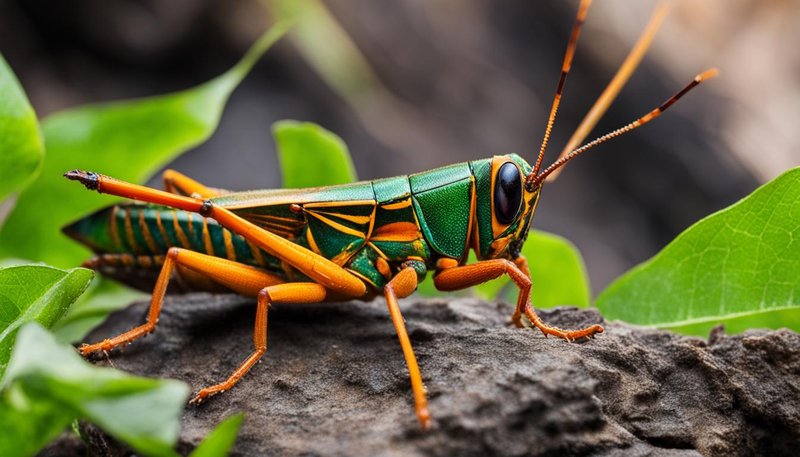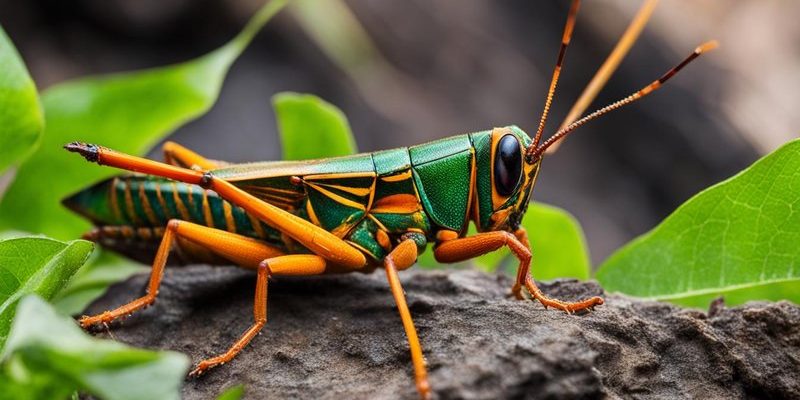
Let’s sit down over coffee and unravel some of these common myths about grasshoppers. We’ll explore their behaviors, habitat, and ecological importance, all while debunking some prevalent misconceptions. By the end, you’ll have a clearer picture of these amazing insects and why they deserve a bit more respect than they often get.
Myth 1: Grasshoppers Are Just Pests
Many people view grasshoppers solely as pests, especially when they invade gardens and crops. But here’s the thing: grasshoppers play a vital role in our ecosystems.
They are herbivores, primarily feeding on grasses and leaves. This feeding habit can actually help with plant growth. By munching on certain plants, they create space for new growth, which benefits the overall health of the ecosystem. Moreover, grasshoppers serve as a food source for birds, reptiles, and other animals. So, while they might nibble on your prized tomatoes from time to time, they’re also a critical part of the food web.
You might be wondering, do they really cause significant damage? While it’s true that large populations of grasshoppers can lead to crop damage, most species only cause minor issues. Farmers often implement sustainable management techniques to keep their populations in check without resorting to harmful pesticides.
Myth 2: All Grasshoppers Can Fly
You’ve probably seen grasshoppers leap into the air, and that might make you think they all have wings and can fly. The reality is a bit different. Not all grasshoppers are created equal when it comes to flying.
Some species can fly, while others, like the popular field grasshopper, prefer to stick to hopping. Flying is particularly useful for escaping predators, but many grasshoppers have adapted to their environments in ways that don’t require flight. Instead, they rely on their impressive jumping ability to evade threats, which can be just as effective.
Interestingly, grasshoppers that can fly tend to have a specific flight season. They usually take to the skies when the weather is warm and conditions are just right. So when you see them soaring around in the summer, know that they’re just enjoying their time in the sun!
Myth 3: Grasshoppers Only Live for a Few Days
Another common myth is that grasshoppers only have a short lifespan, living just a few days. This couldn’t be further from the truth! Grasshoppers have a life cycle divided into distinct stages: egg, nymph, and adult.
Adult grasshoppers can live anywhere from a few months to a year, depending on the species and environmental conditions. They start their lives as eggs, which can survive through winter, hatching into nymphs in the spring. These nymphs look quite similar to adults but lack wings. After several molts, they finally become adults, ready to continue the life cycle.
This longevity allows grasshoppers to adapt to various environmental conditions, which is why you might see them thriving in different habitats, from fields to forests. So next time you see one, remember, it’s not just a fleeting moment in your garden; it’s a life that’s been developing for months!
Myth 4: All Grasshoppers Are Green
When picturing a grasshopper, your mind might jump straight to the classic green variety. But did you know that grasshoppers come in a rainbow of colors?
Color variation is quite common among different species. Some grasshoppers are brown, yellow, or even red! These colors help them blend into their surroundings, making it easier to escape predation. For example, the red-legged grasshopper relies on its more earthy tones to camouflage against the dried grass.
This diversity in coloration isn’t just about aesthetics; it’s a survival technique. A grasshopper’s color can indicate its health and status within its environment. So, if you see a vibrant grasshopper, it might just be flaunting its good health!
Myth 5: Grasshoppers Are the Same as Crickets
Another popular myth is that grasshoppers and crickets are interchangeable. While they may look similar at first glance, they belong to different families and have their unique characteristics.
Grasshoppers are usually larger and have shorter antennae compared to crickets. Crickets, on the other hand, are known for their distinctive chirping sounds produced mainly by males. This song has a purpose: it attracts females and establishes territory. Grasshoppers, while they can produce sounds, do so differently—by rubbing their wings together, like a tiny violin.
Understanding these differences can deepen your appreciation for both grasshoppers and crickets. They each play unique roles in their ecosystem, from pest control to serving as food for other animals.
Myth 6: Grasshoppers Are Nocturnal
You might think that grasshoppers are nocturnal creatures, especially if you’ve spotted them hopping around at night. However, grasshoppers are primarily diurnal, meaning they’re most active during the day.
These insects thrive in warm sunlight, and you’ll often find them basking on leaves or hopping around in the grass during the daytime. Their bright colors reflect their need for sunlight, which helps them with thermoregulation.
While some grasshopper species can be active at night, especially in warmer climates, most prefer the heat of the day. So the next time you see one during daylight, know that it’s just enjoying its time in the spotlight!
Understanding Grasshopper Behavior
Finally, let’s take a look at how grasshoppers behave in their environment. There’s a lot going on beneath the surface of their seemingly simple lives.
Grasshoppers communicate using various sounds and body language. They might wave their antennae or make specific chirping sounds to establish dominance or attract mates. Observing these behaviors can give you a front-row seat to the fascinating world of grasshoppers.
Additionally, grasshoppers are social creatures. They often gather in groups, especially during feeding. This behavior not only helps them find food but also provides safety in numbers against predators. Watching them communicate and move together can offer a unique insight into their lives, making you appreciate these creatures even more.
In conclusion, grasshoppers are much more than just garden pests or simple little bugs. By clearing up these myths, you can see that they play important roles in our ecosystems, contribute to their environments, and possess unique behaviors worth observing. So next time you encounter a grasshopper, take a moment to appreciate its complexity—and maybe even give it a little wave!

